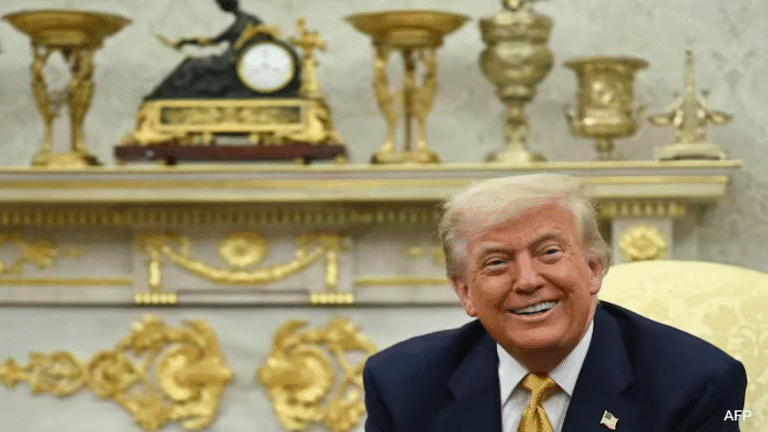
Trump earns $50B in tariff revenue as global powers hesitate to retaliate. Only China and Canada respond as EU, Mexico, others play it safe.

📊 $50 Billion Win: Trump’s Tariff Gamble Pays Off — For Now
Four months into his renewed trade offensive, US President Donald Trump has emerged with a massive economic advantage: nearly $50 billion in customs revenue, according to newly released US Treasury data. Despite fears of a global trade war, most nations have refrained from retaliation, allowing Trump to pursue his high-tariff agenda with minimal blowback — at least for now.
Customs revenue jumped to $64 billion in Q2 2025, up from $17 billion in the same period last year — a stunning increase that underscores the scale of Trump’s aggressive trade policy, which includes:
- A 10% baseline tariff on most imports
- 50% duties on steel and aluminium
- 25% tariffs on automobile imports
🌍 World Watches — But Few Retaliate
While Trump’s tariffs have triggered widespread concerns about a full-scale trade war, only China and Canada have mounted significant retaliatory measures.
🇨🇳 China’s Pushback: Fierce, But Fading
China initially responded forcefully, slapping tariffs of up to 145% on US goods. However, after a 90-day truce agreed in Geneva in May, Beijing scaled back to 30% tariffs, signaling a desire to avoid prolonged escalation.
Despite its strong rhetoric, China’s customs revenue from retaliatory tariffs rose only 1.9% year-on-year in May 2025 — a modest gain compared to Washington’s windfall.
🇨🇦 Canada: Early Resistance, Quick Retreat
Canada launched a C$155 billion retaliatory tariff package, but economic strain forced a strategic pullback. Prime Minister Mark Carney has since shelved a digital services tax and declined to mirror Trump’s doubling of steel duties.
🇲🇽 Mexico: No Retaliation, Just Negotiation
Mexico, now the largest US trading partner, has opted for economic diplomacy. President Claudia Sheinbaum emphasized the need for “stability and pragmatism” and continues to pursue talks over tit-for-tat tactics.
🇪🇺 EU Holds Fire — For Now
The European Union, which prepared a €72 billion retaliation package targeting iconic American goods like bourbon, autos, and aircraft, has delayed implementation. Officials cited the August 1 negotiation deadline set by Trump as a reason for restraint.
🗣️ “These tariffs affect the whole spectrum of US relations, including security,” said an EU official, referencing ties over NATO and support for Ukraine.
The European Commission remains cautious but is preparing for escalation. Trade Commissioner Maros Sefcovic recently warned that a 30% tariff on EU exports would make transatlantic trade nearly impossible.
🏭 Corporate Adaptation: Shifting Supply Chains
Major companies are restructuring sourcing and production to soften the tariff impact. Brands like:
- Apple – Moving assembly to India and Vietnam
- Adidas – Diverting manufacturing to Bangladesh
- Mercedes-Benz – Absorbing higher import costs for US consumers
These efforts reflect a growing reality: businesses are adapting quickly to Trump’s trade playbook to stay competitive in the US market, even as global trade becomes more fragmented.
📈 Historical Perspective: Highest Tariffs Since the 1930s
Trump’s current tariff structure is now the most protectionist since the 1930s Smoot-Hawley Tariff Act, which worsened the Great Depression. Yet in contrast to that era, today’s globalized economy is showing surprising restraint, a shift many experts attribute to lessons learned from the 2018–2019 US-China trade war.
📚 “Retaliation often leads to counter-retaliation rather than negotiated solutions,” says Dr. Marta Bengoa, an international economics professor at City University of New York.
🔮 Analysis: Why the World Is Holding Back
Several key factors explain why nations are cautious:
- Fear of Escalation: Trump has signaled willingness to raise tariffs even further in response to retaliation.
- Geopolitical Leverage: Many US allies depend on Washington for security cooperation, especially in Europe and Asia.
- Economic Fragility: Post-pandemic recovery remains shaky, and retaliatory tariffs risk self-inflicted damage.
- Global Business Pressure: Corporates in exporting nations are urging restraint to preserve access to the US market.
🧠 Expert Take: Smart Strategy or Short-Term Sugar Rush?
While Trump’s tariff regime has filled US coffers, some economists warn it may be a short-term gain with long-term costs:
- Higher prices for US consumers
- Slower global trade growth
- Supply chain disruptions
- Rising tensions among allies
Dr. Bengoa and others caution that without diplomatic breakthroughs, the current pause in retaliation could give way to coordinated backlash, especially if negotiations fail post-August 1.
📌 What’s Next?
Here’s what to watch over the coming weeks:
- EU Decision: Will Brussels activate its €72 billion retaliation plan?
- US-China Truce Extension: Will both sides seek further de-escalation?
- Mexico’s Role: Could Mexico serve as a diplomatic bridge?
- Corporate Shifts: How will global brands continue adapting to rising costs?
💡 Conclusion: Trump’s Tariff Gamble Is Working — But For How Long?
Trump has defied critics with a $50 billion tariff windfall and no major retaliation — so far. Yet the global silence may not last. Behind the scenes, nations are recalibrating, trade blocs are drafting plans, and diplomatic patience is wearing thin.
The world isn’t chickening out — it’s waiting for its moment. And if talks collapse after the August 1 deadline, the global economy may yet feel the full force of the storm brewing beneath.



